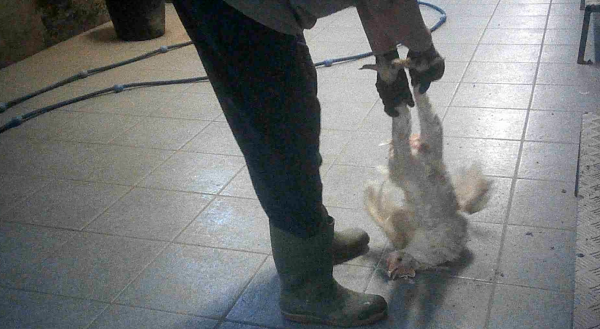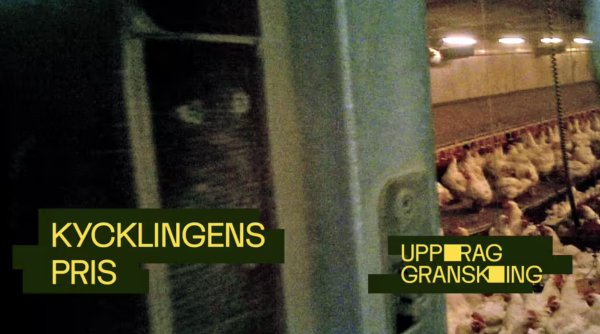1 november 2023
A never-before-seen part of the chicken industry
Animals are tortured and live in miserable conditions at the largest breeding company in the chicken industry. By working undercover and filming with hidden cameras, Djurrättsalliansen can now reveal a key part of the Swedish and European chicken industry.
Today, the Swedish organisation Djurrättsalliansen (the Animal Rights Alliance) releases its latest revelation, filmed using hidden cameras inside Aviagen. By working undercover on the company’s farms in Sweden, Djurrättsalliansen can for the first time reveal the terrible conditions under which breeding animals in the chicken industry live and die. The films are also published by SVT’s Uppdrag granskning, Sweden’s leading TV programme for investigative journalism.
– I had a hard time imagining what I would witness, even though I suspected it would look horrible. But I never imagined that it would look as bad as it did, says the undercover worker, who the Djurrättsalliansen has chosen not to name.
A global industry
The chicken industry is global and every year many billions of chickens are killed worldwide for food. In order to produce all the chickens, the industry relies on several generations of so-called breeding animals, which are transported back and forth within and between countries. When it comes to breeding, a few companies control the entire global market, with Aviagen being by far the largest. Aviagen breeds the Ross 308 chicken hybrid, which accounts for the majority of all chickens that become food.
The Swedish part of the company, Aviagen Swechick, keeps so-called grandparents – grandparents of the chickens that end up on people’s plates. These grandparents are sent by lorry from Scotland to Sweden when they are newly hatched, and then grow up in Aviagen’s Swedish barns, where Djurrättsalliansen has been working undercover and filming with hidden cameras.
Chickens and roosters are kept together to produce fertilised eggs, which contain chicks that in turn grow up to be the parents of the chickens that eventually become food. The fertilised eggs laid on Aviagens Swechick’s farms are sent to the company’s own hatchery. From there, both fertilised eggs and newly hatched chicks are sold. Almost 10 per cent stays in Sweden and is mainly sold to the two leading chicken brands in Sweden, Kronfågel and Guldfågeln. This 10 per cent represents almost 100 per cent of the parent stock in the Swedish poultry industry.
Over 90 per cent are exported, including to Norway, Finland, Denmark, Iceland, Germany, Poland and Spain to be raised and kept as ’parents’ in those countries’ poultry industries.
The films are shown in Swedish media
In SVT’s programme about Djurrättsalliansen’s films, several prominent Swedish experts
react strongly to what the material shows. Per Jensen, professor of ethology, says that the situation for breeding animals in the chicken industry is probably the ”biggest animal welfare problem we have, in all animal breeding”. Despite this, Jenny Yngvesson, a senior lecturer at the Swedish University of Agricultural Sciences, who has researched the chicken industry, says that no journalist has ever asked her about breeding animals before. After seeing the films of how the animals are treated, she says: ”Are you going to show this on TV? Then you have a warning beforehand.”
Uppdrag granskning’s programme, ”Kycklingens pris” (The price of chicken) can be watched here. Uppdrag granskning is one of Sweden’s leading TV programmes for investigative journalism.
Djurrättsalliansen sees only one solution to end the suffering of animals in the chicken industry.
– Animal industries need to shut down. And we hope more people think so after watching these films. If we don’t want to sit here year after year and be shocked by similar revelations, and if it is the animals we really care about, we as humans and society need to act now. The situation of animals is acute and if we only have the will and empathy, we can put a stop to it, by stopping breeding and killing animals for food. This is the only solution that would mean real change for animals, says Malin Gustafsson, spokesperson for Djurrättsalliansen.
Unique revelation of a hidden industry
Few people know what happens when chickens are turned into food, let alone what the chickens’ older relatives have to endure. Now, for the first time, Djurrättsalliansen can show the reality of the animals in that part of the industry.
– We chose to investigate the largest breeding company because there was hardly any transparency about the situation of animals in that part of the industry. Our films show what a sick system we humans have created and what it means for the animals. And now this material is available to everyone and we hope that more and more people will react and act so that this animal cruelty can be stopped, says Malin Gustafsson.
During the autumn, the journalists from SVT tried to enter one of Aviagen’s 13 farms to film, but were not allowed in. Nor did the company itself want to film in the barns and show it to SVT.
– When it comes to showing how these animals live and die, working undercover has been the only way to produce films, as these are hidden and secretive industries that do not show the whole truth. And for us in the Animal Rights Alliance, it is a given to do what it takes to make the lives of animals visible in order to bring about change, says Malin Gustafsson.
The films show industrial, dirty factory environments where thousands of hens and roosters live on a single floor. On just one farm there are up to 20,000 animals.
Since animals in the chicken industry are bred to grow fast, it is also in their genome to eat a lot. But when they eat as much as they want and gain weight, they get sick, have difficulty moving and become less fertile – something that has been called the broiler breeder paradox. One way the industry ”solves” the problem is by starving the breeding animals, which in turn leads to stress and ill health.
The footage shows chickens with broken hips, bald bodies and open wounds. While working undercover the Animal Rights Alliance staff member was able to document how animals are systematically killed in an illegal manner – no stunning is done and there is no verification that the animals are dead.
What Djurrättsalliansen has managed to capture on film is not a one-off, but something the company has been doing for years. The County Administrative Board has repeatedly ordered Aviagen to correct serious deficiencies in the treatment of animals. The issues raised by the The County Administrative Board’s are the same as what our films show: chickens with open wounds, eye injuries indicating high ammonia levels, and sick animals not being treated or euthanised. The County Administrative Board has also witnessed the problem of illegal culling in the past, when the company’s production manager failed to cull a hen despite several attempts. The Board’s reports from the company’s farms also indicate high death rates among the animals – in one stable as many as 30 per cent of the hens had died during the rearing period.
– I particularly remember one occasion when several animals were euthanised. My colleague found a sick rooster in one of the barns. When the colleague held the rooster’s head and turned the body, he did not die. The colleague said that the animals are very heavy and I interpreted that it was therefore difficult to kill them that way. So for the rooster to die, the colleague put the head on the floor, stood on it and pulled the body upwards. They repeated this twice. Even after that, the rooster squirmed and gasped for air. Then he lay in a pool of blood until we picked up all the animals that had been killed and put them in paper bags and put them in freezers. There was a huge sense of powerlessness when injured and sick animals were found and the only ’help’ available was a brutal death, says the undercover worker.

Another chicken hybrid not the solution
Uppdrag granskning’s programme on the Animal Rights Alliance’s films notes that animals in the chicken industry are suffering, but there are different answers to how to solve the problem. The programme highlights the possibility of replacing the fast-growing chicken hybrid Ross 308 with a more ”slow-growing” one. This is also advocated by many animal welfare organisations. But Djurrättsalliansen does not agree that this would solve the basic problem:
– We have been exposing the plight of animals for almost 20 years now. With each revelation, we see strong public reaction, but the public debate rarely discusses whether we should subject animals to this at all. As with any issue of justice, we believe that the issue is that the oppression should not happen at all – not that it should happen in a ’less bad’ way. Switching to a different chicken hybrid might satisfy our consciences that the animals are better off and we can continue to live and eat animals as usual. But the fact is that a change for the animals will not happen, says Malin Gustafsson.
A recently published survey from Swedish farms shows that the basic problems with ”slow growing” chickens are the same. It also showed, for example, that two-thirds of the animals were lame.
– And to even use the term ”slow-growing” in this context is absurd. These are still animals that are bred to grow extremely fast in order to produce large amounts of meat. Changing one part of an entire chain that is wrong will not change anything for the animals, says Malin Gustafsson.
Anything but good life for birds
The ’parents’ that Aviagen sells are in turn raised in barns where hens and roosters come together to produce fertilised eggs. These eggs contain the chicken individuals that eventually become food and are eaten by humans. The chickens live their short lives indoors, crowding 25 chickens per square metre. After just five weeks, they have grown large and are sent to slaughterhouses to be killed.
What you can do:
- Go vegan – don’t eat animals! Do you want help, inspiration and tips to live more animal-friendly? Then check out the Vegan Challenge. A completely free email service where, for 28 days, participants receive recipes, answers to the most common questions, lots of veggie apps and much more. The challenge starts every Monday and you can sign up here. The Vegan Challenge is in Swedish.
- Support our work and help us continue to show the reality of animals by becoming a monthly donor. If you want to make a one-off donation, you can swish to number 123 0730 739 or deposit your one-off donation on our plusgiro account 42 54 11 – 6. You can also make a donation via Paypal. Thank you very much for your support!
- Share our revelations and news to raise awareness of the reality of animals. Follow us on Facebook and Instagram.
- Tip off: if you have information or material that you think could be valuable to us, or if you would like to be involved in exposing animal industries by working undercover – get in touch with us:
Mail: info@djurrattsalliansen.se
Tel: +46 72-300 39 00
